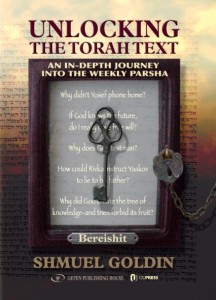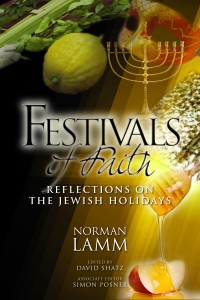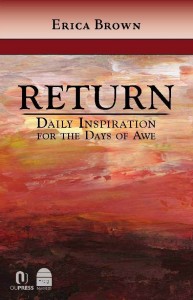Excerpted from Rabbi Shmuel Goldin’s ‘Unlocking The Torah Text: An In-Depth Journey Into The Weekly Parsha- Bereishit‘, co-published by OU Press and Gefen Publishers
Context
One of the strangest and most disturbing episodes in the entire Torah is recorded immediately before the destruction of the city of Sodom. Two of the three angels who earlier visited Avraham now arrive at his nephew Lot’s doorstep in Sodom. Lot showers them with hospitality as he invites them into the protection of his home. It does not take long, however, before the evil inhabitants of the city learn of the angels’ presence and surround Lot’s house demanding that the strangers be given up to them. Seeking to protect his guests from the danger confronting them, Lot reasons with the mob and offers his two unmarried daughters in their stead. The Sodomites refuse the offer, and prepare to storm the house. The angels miraculously afflict their potential attackers with blindness, and then inform Lot that to protect himself and his family he must now leave Sodom.
Questions
How are we to understand Lot’s bizarre behavior? He welcomes strangers into his home, but is then willing to sacrifice his own daughters to mob violence.
Does this episode provide us with any kind of window into Lot’s personality and soul? If so, what does a glimpse through that window reveal?
Approaches
A
With the story of Lot, we are confronted with one of those occasions where a simple, careful, straightforward reading of the biblical text reveals easily missed significance. We must first, however, back up to gain an overview. When we do so, a tragic pattern begins to emerge. This pattern, spanning a number of chapters in the text, enables us to understand Lot and his frightening journey.
B
Our story begins in Parshat Lech Lecha at the point when Avraham and his nephew part ways.
Responding to a dispute that erupts between Avraham’s and Lot’s shepherds, the patriarch turns to his nephew and says: “Let there not be a dispute between you and me and between my shepherds and your shepherds, for we are brothers. Behold, all of the land is before you. Separate yourself from me. If you go left then I will go right, and if you go right I will go left.”
Given the opportunity to choose anywhere within the land of Canaan, Lot chooses the fertile Jordan plain and the Torah states, Va’ye’ehal ad Sodom, “And he tented until Sodom.”
C
Two elements of this phrase immediately catch our attention.
1. First of all, the Torah uses the verb va’ye’ehal, “and he tented,” to describe Lot’s relationship to the land near Sodom.
The two words normally used by the Torah to indicate residence in a particular location are lashevet, “to live,” which connotes permanent residence, and lagur, “to dwell,” which connotes impermanent residence.
Here, however, the Torah chooses to use an even more transient term – “tenting.” Why?
2. Secondly, the word ad, “until,” is an inherently ambiguous one and its use here seems strange.
The rabbis tell us that ad can mean one of two things depending upon context. The word sometimes means “up to and including,” and sometimes means “up to but not including.” (For example, if Jewish law says that a certain object is acceptable ad, “up to,” a height of forty amot [a halachic measurement], the rabbis will still have to define what that means. Is an object forty amot high acceptable, or must the object be, at most, 39.999 amot high?)
By stating that Lot tents “ad Sodom,” the Torah deliberately leaves his situation vague. Is Lot in the city or outside the city? The facts are unclear. The Torah goes out of its way to convey a sense of ambivalence on Lot’s part as he considers his relationship to the city of Sodom. The reasons for this ambivalence are made abundantly clear in the Torah’s very next sentence: “And the citizens of Sodom were greatly evil and sinful towards God.”
Lot is aware of the true nature of the city before him and consciously tents at its border. He literally has one foot in the city and one foot out. He believes that he can live on the edge of Sodom without being affected by its evil.
D
We next encounter Lot a chapter later, when he is taken captive during a war involving Sodom. The Torah states: “And they took Lot and all of his wealth, the son of Avraham’s brother, and they went. V’hu yoshev b’Sodom, and he was living in Sodom.”
The seemingly superfluous phrase v’hu yoshev b’Sodom, “and he is living in Sodom,” is actually chronicling an important transformation. By this point, Lot is no longer living at the edge of the city, but rather “in Sodom.” At first ambivalent about his relationship with Sodom, Lot is now comfortable as a full citizen within its borders.
E
Finally, we meet Lot yet again, this time in Parshat Vayeira five chapters later. The occasion is the event with which we began: the visit of the angels to Sodom. The Torah introduces this event in the following fashion: “And the two angels came to Sodom in the evening; and Lot was sitting b’sha’ar Sodom, in the gates of Sodom.”
You could easily miss it, but the Torah is conveying a very significant point with the two words b’sha’ar Sodom, “in the gates of Sodom.” Only specific people had the privilege of sitting in the gates of a city in biblical times: the elders and officials of that city. By now, Lot’s transformation is complete. He has moved from the edge of the city to its center. Lot is now a respected elder of the evil city of Sodom. The man who felt that he would be able to withstand the lure of the city has fallen prey to its power.
F
With the pattern of Lot’s personal transformation as a backdrop, we can now begin to understand his seemingly inexplicable behavior when confronted with the threatening mob outside his door.
Lot is not an evil, but, rather, a weak man. His most fatal flaw, in fact, is his failure to recognize his own vulnerability. He believes that he can withstand the temptations of Sodom. Without realizing it, however, he is sucked in and indelibly transformed by the city around him. The Torah testifies that you cannot live near Sodom and remain unchanged.
At the most critical juncture of his life, Lot displays the aberrant behavior of a man who is trying to reconcile the irreconcilable. On the one hand, he desperately attempts to hold true to the traditions he witnessed in his Uncle Avraham’s tent. He welcomes guests and treats them royally. He is willing to go to any lengths to protect them. At the same time, however, he seamlessly crosses over into the horrific world of Sodom and offers to sacrifice his own daughters to a brutal fate. Lot fails because he believes that he can live in two worlds at once – in two worlds which simply cannot coexist.
Points to Ponder
Over the course of several chapters, the Torah clearly chronicles Lot’s step- by- step transformation: an unwitting journey into the hell that is Sodom.
Lot’s story remains a cautionary tale concerning the effects of external environment on our lives. We must be ever aware of the world that surrounds us, and we must actively reject those elements of our surroundings that are incompatible with our own standards.
Through such vigilance, we will escape Lot’s fate.








